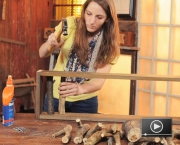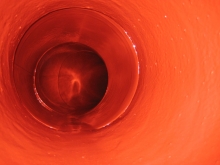- Error
{Re}habitat
Learn how adaptive reuse and upcycling can add hip design to your home, apartment, or yard with the Go Green channel's {Re}habitat series. Follow host Rachael Ranney as she shows you how to repurpose salvaged and found materials, adding fun and function to your space without breaking your budget.

Find out, step by step, how to create two very different DIY coat racks using both natural and recycled materials. Watch {Re}habitat, Rachael Ranney’s online video series, to learn how adaptive reuse can add fun and function to your space.
I am constantly looking for ways to create new and inexpensive storage for my small home. Throughout the winter and spring months here in the Midwest, my house is always cluttered with a flurry of coats, gloves, and other cold weather gear. Installing a coat rack near your front door will add storage capacity to your entryway and can help you to clear up some of the chaos.
Jeff Wilson shares his views on how the ordinary DIYer can perform acts of patriotism while improving things around the house!
It’s not often that you pick up a hammer, get back to work on that DIY home improvement project, and consider it an act of patriotism, but that’s exactly what we should be doing – each and every one of us.
Brooks + Scarpa Architects: Warehouse Design for the 21st Century
Written by Kristin Dispenza Mon Feb 27 2012A traditional industrial building type is adapted to create a modern, sustainable facility in Mexico.
The Mexican government recently developed a new Research and Technology Innovation Park (Parque de Investigación e Innovación Tecnológica or PIIT) in Monterrey. An automotive company that manufactures chassis for heavy trucks and pickups selected a 100,000 sq. ft. parcel within the research park as the site of its new building – a research lab, office, and industrial testing facility. Brooks + Scarpa Architects, based in Los Angeles, designed the structure.
What is the best way for a construction observer to train? Learning from a professional on site may be ideal, but other good sources of information include public agencies and the documentation they make available.
Columnist David A. Todd, P.E., CPESC, has 37 years of experience in the architecture, engineering, and construction (AEC) industry and has performed much construction administration during that time. He will answer questions from our readers or from his own practice and will provide answers based on his understanding of the construction process.
The NAHB International Builders' Show is the place to go to check out the latest building products. Jeff Wilson attended the 2012 show in Orlando and here shares his favorite finds.
There's nothing like escaping the Midwest and going to Florida in the middle of winter. That’s what I got to do recently in Orlando at the National Association of Homebuilders’ International Builders’ Show 2012. While I attended as a host and presenter for LP Building Products, I also got a chance to check out the booths and exhibits.
The use of epoxy coatings and epoxy-coated structural liners can save both time and money over traditional pipe repair methods.
Damaged or deteriorating pipe systems can be expensive to replace, particularly those that are located in hard-to-reach locations or inaccessible without selective demolition. Fortunately, common pipe systems can be rehabilitated from within, using cured-in-place epoxy coatings or epoxy-coated structural liners. These in-situ pipe repair techniques can offer cost savings of up to 60% and time savings of up to 30% when compared to traditional pipe repair methods. We’ve partnered with Nu Flow America to highlight several different in-situ pipe repair techniques available to facility managers and building owners.
The use of epoxy coatings and epoxy-coated structural liners can save both time and money over traditional pipe repair methods.
Damaged or deteriorating pipe systems can be expensive to replace, particularly those that are located in hard-to-reach locations or inaccessible without selective demolition. Fortunately, common pipe systems can be rehabilitated from within, using cured-in-place epoxy coatings or epoxy-coated structural liners. These in situ pipe repair techniques can offer cost savings of up to 60% and time savings of up to 30% when compared to traditional pipe repair methods. We’ve partnered with Nu Flow to highlight several different in situ pipe repair techniques available to facility managers and building owners.
A Spanish Renaissance building in Houston gets a much needed restoration and is finally completed, according to the architect’s original intent, more than 80 years after the first stone was laid.
The Julia Ideson Building has been a Houston landmark since it opened in 1926. Designed by architect Ralph Adams Cram of the Boston firm Cram and Ferguson, the Spanish Renaissance structure served as the Houston Central Library until 1976 and has long been regarded as one of the city’s most prominent public buildings. The library’s first director, Julia Ideson, was also regarded as one of Houston’s most prominent citizens.







